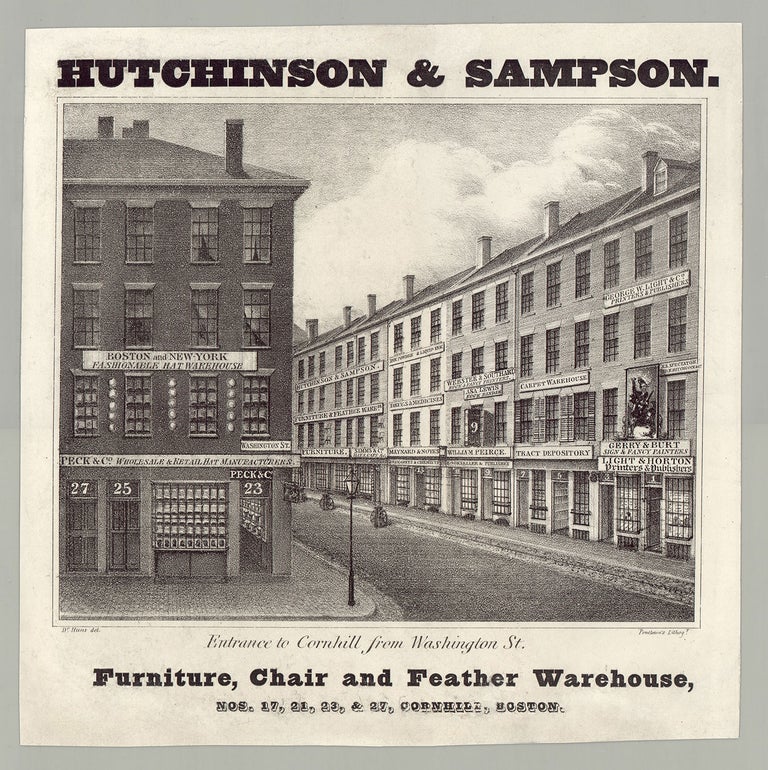Hutchinson & Sampson. Entrance to Cornhill from Washington St. Furniture, Chair and Feather Warehouse, Nos. 17, 21, 23, & 27 Cornhill, Boston.
Boston: Pendleton’s lithog., [ca. 1831]. Lithograph, 8.5” x 10.5”, plus margins. Recently backed with Japanese tissue. An appealing advertising lithograph picturing a Boston furniture warehouse nestled among a delightful range of other shops. Hutchinson & Sampson’s establishment is shown here located on Cornhill St. with signs on three floors and four chairs—three dimensional emblems of their trade—hanging from the face of the building. The block is also occupied by “Simms & Co. Hats, Caps &c.,” Maynard & Noyes Druggists & Chemists,” ‘Webster & Southard Book & Fancy Printers,” “Asa Lewis Book Binder,” and various other shops. Above the entrance to Gerry & Burt, Sign & Fancy Painters is a large, intriguing trade sign of what appears to be a figure on horseback. Elijah Gibbs Hutchinson of the firm Hutchinson & Sampson is recorded as a furniture dealer in Cornhill, Boston in 1830. Artist William Hunt (fl. 1834–38) drew a number of views on stone for both William Pendleton and Thomas Moore. These included three views of Charles Greene’s Academy (a Boston prep school); View of the Post Office, City Hall, etc., taken from the S.W. in Washington St., Boston; and Joy's building including Messrs. S. & A.H. Rhoades' Hat Store, no. 63, and stores to no. 87 inclusive, western side of Washington St. On several of these Hunt is credited as “Wm. Hunt, M.D.” In addition, Hunt wrote and published A Concise Introduction to Phrenology, which included an illustration of Dr. Johann Gaspar Spurzheim (a leading phrenologist and lecturer on the subject), and designed and published a lithograph of the Spurzheim monument in Mt. Auburn cemetery. These latter works suggest that Hunt himself was a phrenologist. Pendleton also published a drawing book by Hunt, Dr. Hunt’s Drawing Book, which consisted of four plates without text. Operating from 1825 to 1836, Pendleton’s Lithography was founded by brothers William Pendleton (1795–1879) and John Pendleton (1798–1866) at Harvard Place in Boston. The city’s first shop of its kind, Pendleton’s was also one of the finest lithographers of its era. Prior to the formation of the firm, William had founded Senefelder Lithographic Co. in 1825 with Abel Bowen. A range of artists—many of them prominent—learned the art of lithography while working at Pendleton’s, including Fitz Henry Lane, John H. Bufford, Seth Cheney, Nathaniel Currier, Thomas Edwards, B.F. Nutting, George L. Brown, Benjamin Champney, Alexander Jackson Davis, David Claypoole Johnston, Robert Cooke, William Rimmer, and John W.A. Scott. These artists created a wide variety of materials: maps, plans, portraits, fashion plates, topographical views, sheet-music covers, advertisements, and historical prints. In 1826, the brothers won a silver medal for the “Best Specimen of Lithography” at the annual exhibition of the Franklin Institute, Philadelphia. OCLC records only one copy of this print, at the Boston Athenaeum. REFERENCES: Last, Jay. The Color Explosion : Nineteenth-Century American Lithography (Santa Ana, CA, 2005), pp. 120-121; Pierce, Sally and Catharina Slautterback. Boston Lithography, 1825–1880 (Boston, 1991), pp. 146-147, 175. CONDITION: Very good, some rubbing and light soiling to margins.
Item #6122
Sold


